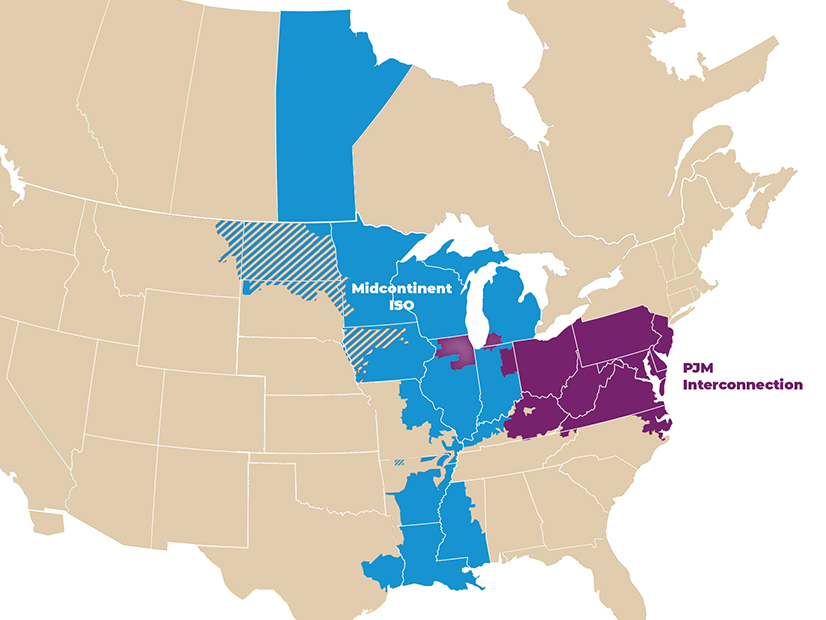The state regulatory organizations for both MISO and PJM have sent a letter to the RTOs asking them to redouble efforts around interregional transmission planning.
The Organization of MISO States (OMS) and the Organization of PJM States, Inc. (OPSI) penned a joint letter to MISO and PJM, telling them the time is right to initiate long-term interregional transmission planning. The letter was signed by the presidents of OMS and OPSI and addressed to the RTOs’ Interregional Planning Stakeholder Advisory Committee. MISO South state agencies didn’t participate in the letter.
“The transition from dispatchable thermal generators to intermittent, clean energy resources, and a surge in electric demand raise challenges to PJM, MISO and their interconnected neighbors’ ability to reliably and cost-effectively support one another when called upon,” OMS and OPSI wrote.
The organizations said their concerns are heightened by increasingly common severe weather. They said MISO and PJM were “heavily dependent” on one another’s resources while importing and exporting to other neighboring regions during the December 2022 arctic blast. They also said last August’s heatwave forced MISO to import roughly 8.5 GW from PJM and Manitoba.
“While these events were managed, the growing frequency of these events and shrinking capacity reserves in each footprint [have] the potential to disrupt electricity supplies, which in turn disrupts the economy and may put public health and safety at risk. Expanding transfer capacity between regions can help to improve grid resilience and minimize the negative impacts of extreme weather events,”
OMS and OPSI pointed to the U.S. Department of Energy’s recent National Transmission Needs study, FERC considering a rule to establish a minimum transfer capability between regions and Congress tasking NERC with studying interregional transmission capacity.
“With these factors in mind, OPSI and the OMS urge PJM and MISO to begin to explore joint long-term interregional transmission planning between their footprints while maintaining a focus on affordability and identifying optimal solutions,” the organizations wrote.
The two said MISO and PJM should jointly model their systems, work with state regulators to agree on reliability and policy objectives, and borrow from their existing long-term planning to devise an interregional process.
“Both of our organizations have a renewed focus on interregional planning,” OMS Executive Director Marcus Hawkins said during a Feb. 7 MISO Advisory Committee teleconference.
RTOs Respond
MISO responded that it’s always looking to improve its planning processes, including interregional planning.
“MISO has a long history of performing coordinated interregional transmission planning with its neighboring grid operators. Interregional planning helps us identify projects that improve the system’s ability to mitigate constraints, respond to extreme weather and increase interregional transfer capability,” spokesperson Brandon Morris said in an emailed statement to RTO Insider.
Morris said MISO appreciates the regulators’ input and looks forward to “enhancing our work with our neighboring transmission planning partners while balancing our staffing needs to identify and move forward the regional and interregional solutions needed to respond to the evolving resource mix.”
PJM spokesperson Jeffrey Shields said PJM already engages in healthy collaboration with its neighbors to identify congestion-relieving and reliability-boosting projects, as outlined in the MISO-PJM joint operating agreement.
In an emailed statement to RTO Insider, Shields said PJM has significant export capability, as evidenced by the 12 GW in exports PJM flowed to neighbors at the height of the mid-January arctic blast.
“At the same time, PJM is committed to working with MISO and others to determine if more should be done with interregional transmission. That discussion is ongoing,” Shields said. “PJM believes that the best way forward is with analysis on how best to define whether and what level of transmission solutions are needed to ensure sufficient interregional transfer capability. We need to understand very clearly what the problem is that we’re solving for before committing significant investments that will be borne by customers.”
Shields said while a minimum transfer capability is “sensible,” interregional planning should not become a substitute for RTOs maintaining adequate reserve margins.
“If all of our regions are hit with the same winter storm, the results could be very harmful to consumers,” he said.
The grid operators will address the regulatory organizations’ request again at the March 1 teleconference of their Interregional Planning Stakeholder Advisory Committee.
MISO and PJM have approved one large interregional market efficiency project in 2020 and four sets of smaller transmission projects aimed at relieving congestion since 2017. The two haven’t completed an interregional transmission planning study since 2022.
In a report last year, the American Council on Renewable Energy concluded MISO and PJM could save their ratepayers $15 billion over a little more than a decade if they dedicated more resources to planning interregional transmission. (See New Report Finds MISO, PJM Could Save Billions Through Interregional Tx Expansion.)




